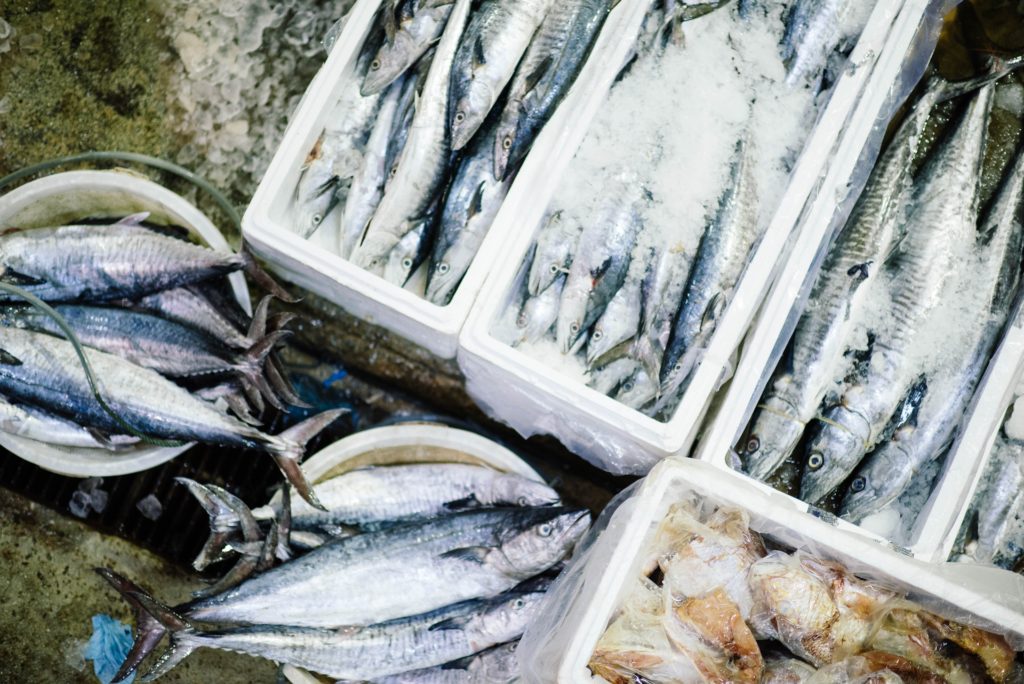All fields are required
Posted in Food Safety on October 29, 2018

Are you at risk of radiation from the Fukushima nuclear disaster that Japan suffered in the wake of a 2011 tsunami? Are we eating radioactive seafood? Should we be concerned about our fish?
Certain posts on Facebook would have you think so. I had an ecologically minded friend put one on my timeline this week. In an accompanying comment, they warned that the government was covering up the true extent of the Fukushima disaster, and any seafood from the Pacific was likely compromised by nuclear radiation that had leaked out of the plant. Accompanying their post was a dramatic graphic, with the Pacific ocean colored in various hues; extending from Fukushima, there was a bright blue tongue, and around the blue tongue were long arms of yellow and orange that stretched across the ocean to the coast of the Americas. It looked like a jet of flame licking the coastline.
The idea surprised me. Was it possible that marine ecosystems were still struggling with the effects of Fukushima? Could one nuclear meltdown really contaminate the Pacific Ocean so badly that the environmental effects were still resonating, all these years later? And could it be that the regulatory agencies charged with detecting such a threat either hadn’t done so, or were unwilling to share the true extent of the contamination with the public that they supposedly protect?
I set down to Googling. Eventually, through the help of the fact-checking site Snopes, I found the image that had been shared along with an article on my Facebook timeline. According to Snopes, the image that had been attached to my article wasn’t a chart of radiation seepage from Fukushima at all. Instead, it was a map from the National Oceanic and Atmospheric Administration showing the height of the tsunami wave which damaged the nuclear reactor and led to a meltdown in the first place. Their rebuttal to this particular piece of misinformation dated all the way back to 2013. That’s a pretty long half-life (no pun intended) for a rumor, and I was surprised that it was still churning through my social media circles.
So I kept Googling, and I learned more about the Fukushima meltdown than I expected to. In the event of a major nuclear accident like the meltdown at Fukushima, several different kinds of radiation are released. Some are more dangerous to human health than others. Of primary concern is the release of a deadly radioactive isotope called iodine-131. Your thyroid takes up iodine from the environment in order to function properly; if it absorbs iodine-131, you’re likely to get thyroid cancer within the next few years. Should you breathe in iodine-131, or consume it in your water or food, your health is at serious risk.
One thing about iodine-131: it doesn’t stick around for very long. The half-life of the element is only 8 hours. And the majority of the iodine-131 released during the Fukushima disaster was deposited into the ocean. Although Japanese doctors did register an uptick in thyroid tumors in the affected population following the disaster, there was no ocean-wide poisoning event from radioactive iodine that threatens us to this day.
Other isotopes were released by Fukushima, of course. Chief amongst them is Cesium-134, which is a telltale sign of human nuclear activity. There are no natural sources of the isotope, so it can be used to track radiation from human sources like Fukushima. In 2015, Canadian inspectors came across a salmon that tested positive for a marginal level of cesium-134, which they were able to link to the Fukushima disaster four years previous.
Notable here is that the level of cesium-134 detected in the fish was less than one thousandth of the level of radiation that’s considered unsafe for people to consume. It was, in fact, consistent with the natural amount of radiation that you’d expect to see in a fish, nuclear accident or otherwise; we’re all exposed to radiation throughout the day from a number of different sources, and most living things carry in them a similarly marginal amount of radioactive isotopes. The only thing notable here is that the isotope in question had made it across the Pacific, four years after the fact.
The single salmon, in fact, wasn’t the first time that investigators had found cesium-134 signatures in fish. That would probably be a study of bluefin tuna from 2011 which similarly found that fish along the west coast displayed the distinctive fingerprint of the nuclear disaster. As was the case with the salmon, the radioactive isotopes were distinctive, but the amount of radiation was consistent with what you find in a normal living thing.
According to PBS Newshour, about 80% of the fallout from Fukushima made it into the ocean. That radiation was swept up by the Kuroshio Current, where it was dispersed and diluted through the massive amount of seawater in the Pacific Ocean. Because most of the fallout was deposited into the ocean, people near Fukushima were exposed to a fraction of the deadly radiation that befell victims of Chernobyl.
Nonetheless, rumors about the hidden effects of Fukushima have persisted. Images circulated that supposedly depicted fish in the wake of the disaster, deformed by unsightly growths and tumors; that post, too, was a hoax, made up of images collected from various corners of the internet.
This isn’t to say that the Fukushima disaster didn’t have an effect on the plant and animal life living near the meltdown (it did), or that the radiation is completely absent from the Pacific (as the fish demonstrate, it’s not). The lie is that the radiation has contaminated all marine life in the Pacific through to the west coast, and that we’ve been sold a radioactive bill of goods in order to keep the fishing industry afloat. The evidence simply doesn’t support it.
By: Sean McNulty, Contributing Writer (Non-Lawyer)